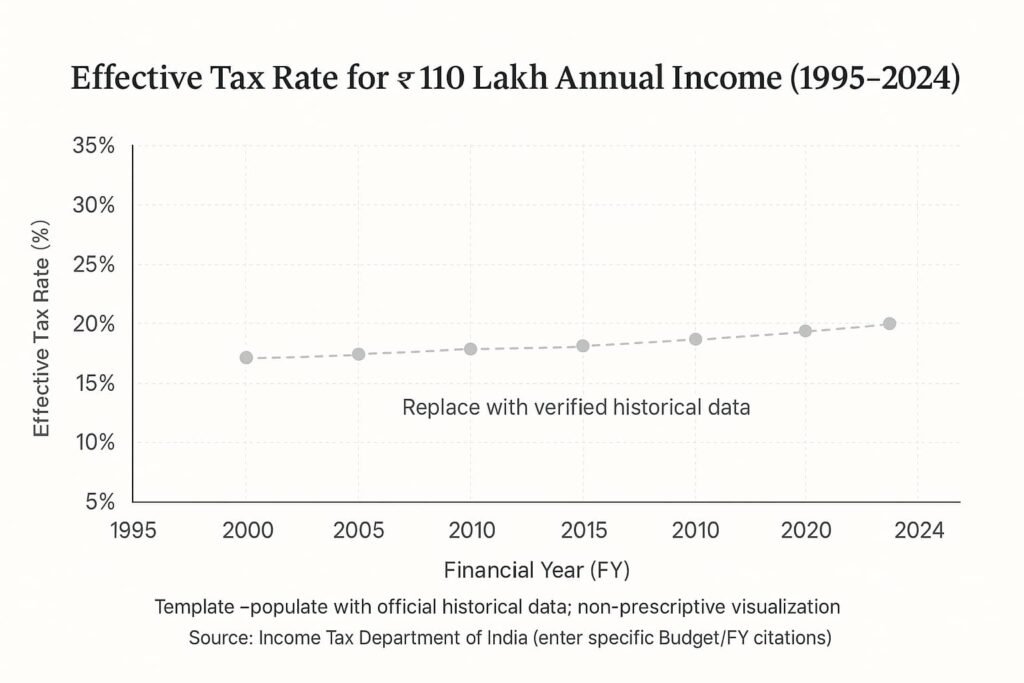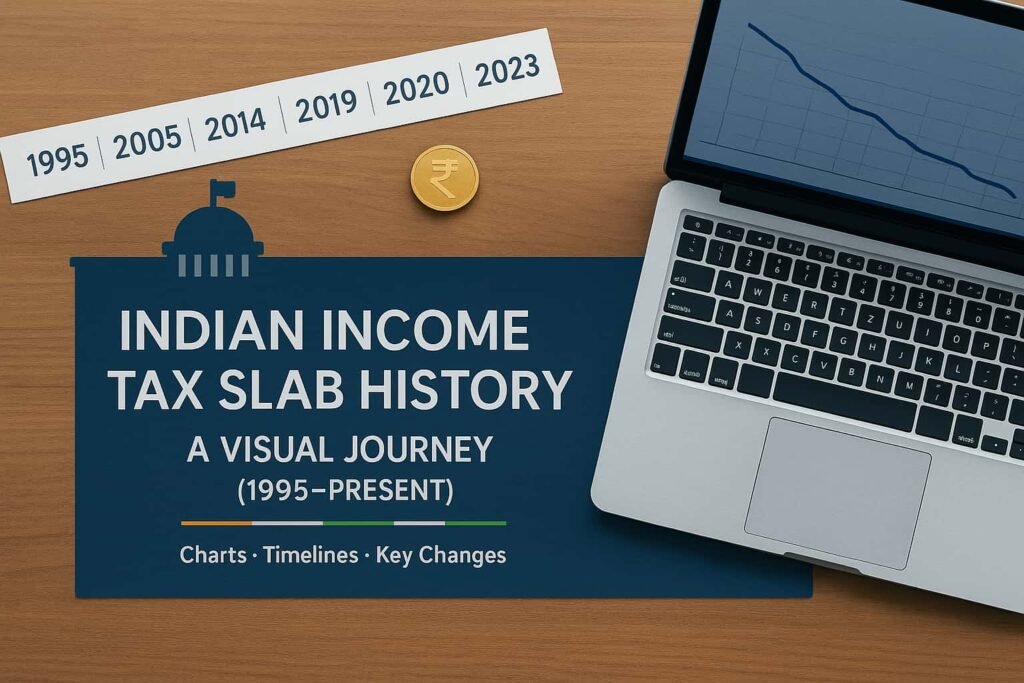Indian income tax slab history tracks how rates, thresholds, and structures have shifted from the mid-1990s to today. Over three decades, policy moved from complex slabs toward clearer bands, periodic increases in the basic exemption, and—most recently—an optional new regime that trades many deductions for lower rates. This article presents a concise timeline (1995–present), side-by-side tables for milestone years (2014, 2017, 2019, 2020, 2023), and plain definitions so readers can see what changed and why in context. The information is drawn from official government sources and is provided for educational and informational purposes only.
What is a “tax slab”?
Tax slab: A range of income taxed at a specific rate in a progressive system (only the income within each slab is taxed at that slab’s rate).
Basic exemption limit: Income up to the notified threshold isn’t taxed for the relevant taxpayer category.
Rebate (Section 87A): A relief that reduces income-tax for eligible resident individuals below a threshold; applied before surcharge and cess.
Surcharge: An additional percentage on the income-tax for higher-income ranges (varies by threshold).
Health & Education cess: A percentage applied on income-tax + surcharge.
Calculation order (simplified):
Compute income-tax by slabs → apply rebate (87A) if eligible → add surcharge (if applicable) → add cess.
Note: Slab thresholds and some rules can differ by taxpayer category (e.g., senior citizens) and year. This section defines terms only—no advice.
Milestone Timeline (1995–Present)
Beyond the numbers of each slab, understanding the timeline of tax changes can offer deeper insights into India’s evolving economic policies. The following timeline highlights the major milestones in the Indian tax system, showing how the government has consistently aimed to simplify the process and provide relief to different income groups over the past three decades.
| Period / FY | What changed | Why (policy aim) |
|---|---|---|
| 1995–2004 | Rationalisation; 10%–20%–30% becomes familiar | Lower very high rates; broaden base |
| 2005–2013 | Stable three-slab era | Predictability; ease of understanding |
| 2014–2016 | Basic exemption to ₹2.5L (non-senior) | Entry-level relief; inflation adjustment |
| FY 2017–18 | ₹2.5–5L slab cut to 5% | Relief for lower incomes |
| FY 2019–20 | Enhanced 87A rebate up to ₹5L | Relief without redrawing slabs |
| FY 2020–21 | New Regime introduced (115BAC) | Simplification; fewer deductions, lower rates |
| FY 2023–24 → | New Regime simplified & default | Streamlined baseline; easier compliance |
Note: Values typically refer to non-senior resident individuals. Surcharge/cess rules vary by year.
Big-picture timeline (1995–Present)
Use this timeline to see how slab rates, thresholds, and policy design shifted from 1995 to today. It highlights milestone reforms, their stated aims (simplification, inflation adjustment, relief at lower incomes), and the emergence of the optional new regime alongside the old. Each phase is dated and factual so readers can quickly compare “then vs now.”
1995–2004 — Consolidation & rationalisation
Shift from early-1990s complexity toward fewer, clearer slabs.
By the late 1990s (“Dream Budget” era), the 10%–20%–30% structure became familiar.
Emphasis on lowering very high marginal rates and broadening the base.
Why it mattered: Set the foundation for a simpler, more predictable system.
2005–2013 — Stable three-slab phase
Slabs for non-senior individuals stabilised around three clear rates.
Basic exemption limit was raised periodically to offset inflation.
Year-to-year changes were modest and predictable.
Why it mattered: Created a long stretch of stability that taxpayers could understand easily.
2014–2016 — Higher exemption, steady rates
Basic exemption (non-senior) increased to ₹2.5 lakh (from ₹2 lakh).
The 10% / 20% / 30% band logic continued.
Why it mattered: More entry-level relief without altering the overall structure.
2017–2019 — Relief at the lower band; rebate gains importance
FY 2017–18: The ₹2.5–5 lakh slab rate cut from 10% to 5%.
Section 87A rebate was adjusted; by FY 2019–20, many resident individuals up to ₹5 lakh total income had nil net tax (subject to conditions), without changing slabs.
Why it mattered: Delivered bottom-tier relief via a mix of slab tweak (2017) and rebate design (2019).
2020–2022 — Optional New Tax Regime (NTR) introduced
FY 2020–21: Launch of Section 115BAC (NTR) with more slabs, lower rates, and most deductions foregone.
The Old Regime continued; eligible taxpayers could choose annually.
Why it mattered: Brought a parallel, simplified path trading deductions for lower nominal rates.
2023–Present — New Regime simplified and made default
FY 2023–24: NTR redesigned into fewer, wider bands with added reliefs.
Rebate in NTR raised so many pay zero up to ₹7 lakh (conditions apply).
Standard deduction allowed for salaried/pensioners in NTR.
NTR set as default, while Old Regime remains available.
As of FY 2024–25, this revised NTR continues alongside the Old Regime.
Era Overview Matrix (1995–Present)
A phase-by-phase summary of how slabs evolved and why. Values refer to non-senior individuals unless noted.
| Phase | Years (FY) | Indicative slab design | Basic exemption (indicative) | Notable moves |
|---|---|---|---|---|
| Consolidation | 1995–2004 | Rationalisation toward 10%–20%–30% | Varied across the decade | Lower very high marginal rates; broaden base |
| Stable three-slab | 2005–2013 | Three clear bands (10/20/30) | Periodic increases | Predictability; ease of understanding |
| Higher exemption | 2014–2016 | 10/20/30 structure continues | ₹2.5 lakh (non-senior) | Entry-level relief via higher threshold |
| Lower first slab + rebate | 2017–2019 | First taxable slab cut to 5% | ₹2.5 lakh (non-senior) | Enhanced 87A rebate up to ₹5L (FY 2019–20) |
| Parallel regime introduced | 2020–2022 | New Regime (more bands, lower rates) | Old: ₹2.5L (non-senior) | Optional NTR (115BAC); fewer deductions |
| Simplified default baseline | 2023–Present | Revised NTR: fewer, wider bands | NTR: 0–₹3L at 0% | Rebate nil up to ₹7L (cond.); standard deduction allowed; NTR default |
Note: Surcharge/cess and category-specific thresholds vary by year.
Old vs New Regime — Current Structure
Understanding the differences between the old and new tax regimes is essential for taxpayers in India. The table below provides a factual, side-by-side comparison of the key features of both tax regimes as they stand for the current financial year.
| Feature | Old Regime | New Regime (from FY 2023–24) |
|---|---|---|
| Slab bands | 5% / 20% / 30% (typical) | 0% / 5% / 10% / 15% / 20% / 30% |
| Basic exemption | ₹2.5 lakh (non-senior) | 0–₹3 lakh at 0% |
| Deductions/allowances | Many popular ones available (as per law) | Limited; simpler compliance intent |
| Rebate (87A) | Available as per FY rules | Nil up to ₹7 lakh for many (conditions) |
| Default/choice | Available | Default (Old Regime still available) |
| Cess & surcharge | Apply as per FY rules | Apply as per FY rules |
Note: Category-specific thresholds (e.g., senior/super-senior) and eligibility rules vary by FY.
How to visualise this history
Use neutral, fact-only visuals that label the year, the rule in force, and the source. Each graphic should show what changed without implying any action or recommendation.
Timeline strip: Mark key years — 1997 (rationalisation), 2005 (three-slab stability), 2014 (higher exemption), 2017 (5% first slab), 2019 (rebate up to ₹5L), 2020 (launch of New Regime), 2023 (New Regime refreshed). Add one-line captions like “Rate cut in first slab” or “Rebate threshold revised.”
Rate-over-time line: For a fixed taxable income (e.g., ₹5,00,000, computed under the rules of that year), plot either the statutory slab rate applying to the top portion or the effective tax liability. Keep assumptions consistent (non-senior individual; note when rebate applies). Clearly footnote that surcharge/cess rules vary by year.
Before/After cards: Compact “old vs new” snapshots for 2014, 2017, 2019, 2020, 2023. Each card shows slabs and rates side-by-side, with a one-line “What changed” tag (e.g., “Entry slab reduced to 5%” or “New Regime introduced with multiple lower rates”).

Why did slabs change?
A neutral summary of the main policy drivers behind slab revisions—what governments sought to balance over time, without suggesting any action.
Inflation & relief: Periodic increases in the basic exemption help counter bracket creep so lower incomes remain untaxed or lightly taxed.
Simplicity vs incentives: India long used deductions/exemptions to nudge saving and insurance. The New Regime tests a simpler path—lower rates with fewer deductions to ease compliance.
Equity & buoyancy: A progressive structure aims to share the burden by ability to pay while supporting revenue needs as the economy grows.
Administrative ease: Fewer slabs and fewer deductions can reduce disputes, interpretation gaps, and return-filing complexity.
Note: Exact thresholds, rates, surcharges, and eligibility vary by year and taxpayer category; this section explains motives, not choices.
Key terms—at a glance
Old Regime: Traditional slab rates with widely used exemptions/deductions (subject to eligibility and limits).
New Regime (Section 115BAC): Optional structure featuring lower rates with limited deductions; refreshed in 2023 and made the default while the Old Regime remains available.
Rebate (Section 87A): Relief that can reduce income-tax to zero below a notified threshold (varies by year); applied before surcharge and cess.
Surcharge: An additional percentage on income-tax for higher-income ranges; thresholds and rates vary by year.
Cess (Health & Education): A percentage applied on income-tax + surcharge to fund specified social programs.
These definitions are purely descriptive; actual thresholds and eligibility depend on the relevant financial year and taxpayer category
From the mid-1990s to today, India’s personal income tax has followed a steady simplification arc: very high marginal rates were rationalised into clearer slabs, the basic exemption was lifted at intervals to offset inflation, entry-level relief expanded (e.g., the 5% first slab from FY 2017–18 and the enhanced 87A rebate in FY 2019–20), and an optional New Regime (from FY 2020–21, refreshed in FY 2023–24) now coexists with the Old Regime. The result is a dual-path framework—one streamlined baseline and one deduction-friendly alternative—aimed at clarity and easier compliance while maintaining relief for lower incomes.
FAQs
What period does this history cover?
What is a tax slab?
What is meant by the “Old” and “New” regimes?
When was the first taxable slab reduced to 5%?
What changed in FY 2019–20 with Section 87A?
What are the revised New Regime slabs from FY 2023–24?
Are surcharge and cess included in the snapshots?
What sources were used?
Is this article for educational use only?
Disclaimer: This is a historical and educational overview of Indian income-tax slabs. It does not include instructions for individual situations.
Disclaimer: “This article is a historical and educational overview of Indian tax slabs and should not be considered as professional financial or tax advice. Readers should consult with a qualified tax advisor for personalized guidance.”
About Seva Funds & Important Disclosures
About the Author
Prashant SN
Education: MCom (Master of Commerce)
What I enjoy: Finance calculations and building easy tools for everyday decisions
Hi, I am Prashant SN. I studied MCom and I am interested in finance calculation. I started Seva Funds to share clean, fast calculators and no-nonsense explanations for India.
Disclaimer
This website and its content are for informational and educational purposes only. It is not intended to be and does not constitute financial, legal, or any other type of professional advice. We do not guarantee the accuracy, completeness, or usefulness of any information on the site. Always consult with a qualified financial professional before making any financial decisions.
More from SevaFunds
- UPI vs Bank Apps in India: What’s the difference? — a plain-English comparison of how UPI works versus bank apps, with everyday use-cases.
- Increase CIBIL Score from 750 to 800 — explains factors that influence scores and common checks to keep reports accurate.
- Disadvantages of Scientific Calculators — when advanced calculators can be counter-productive for learning and exams.


